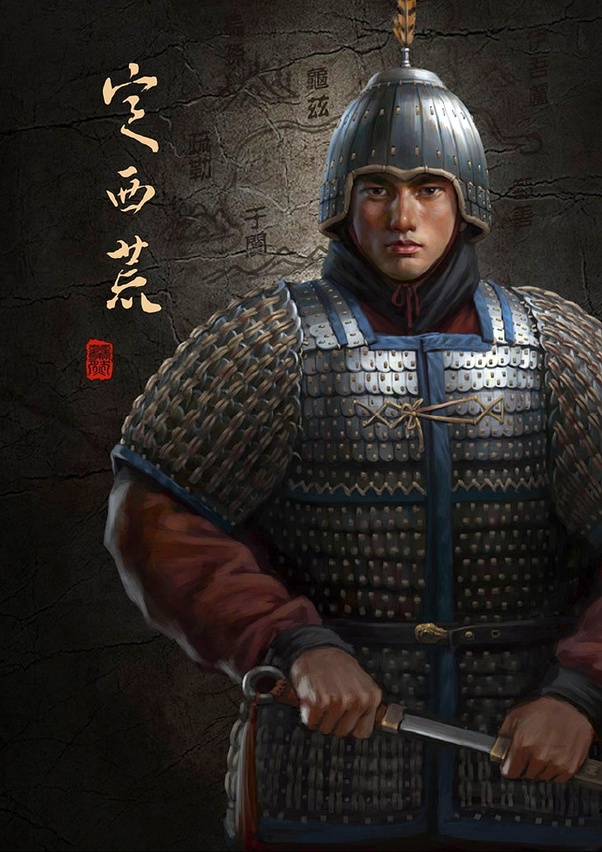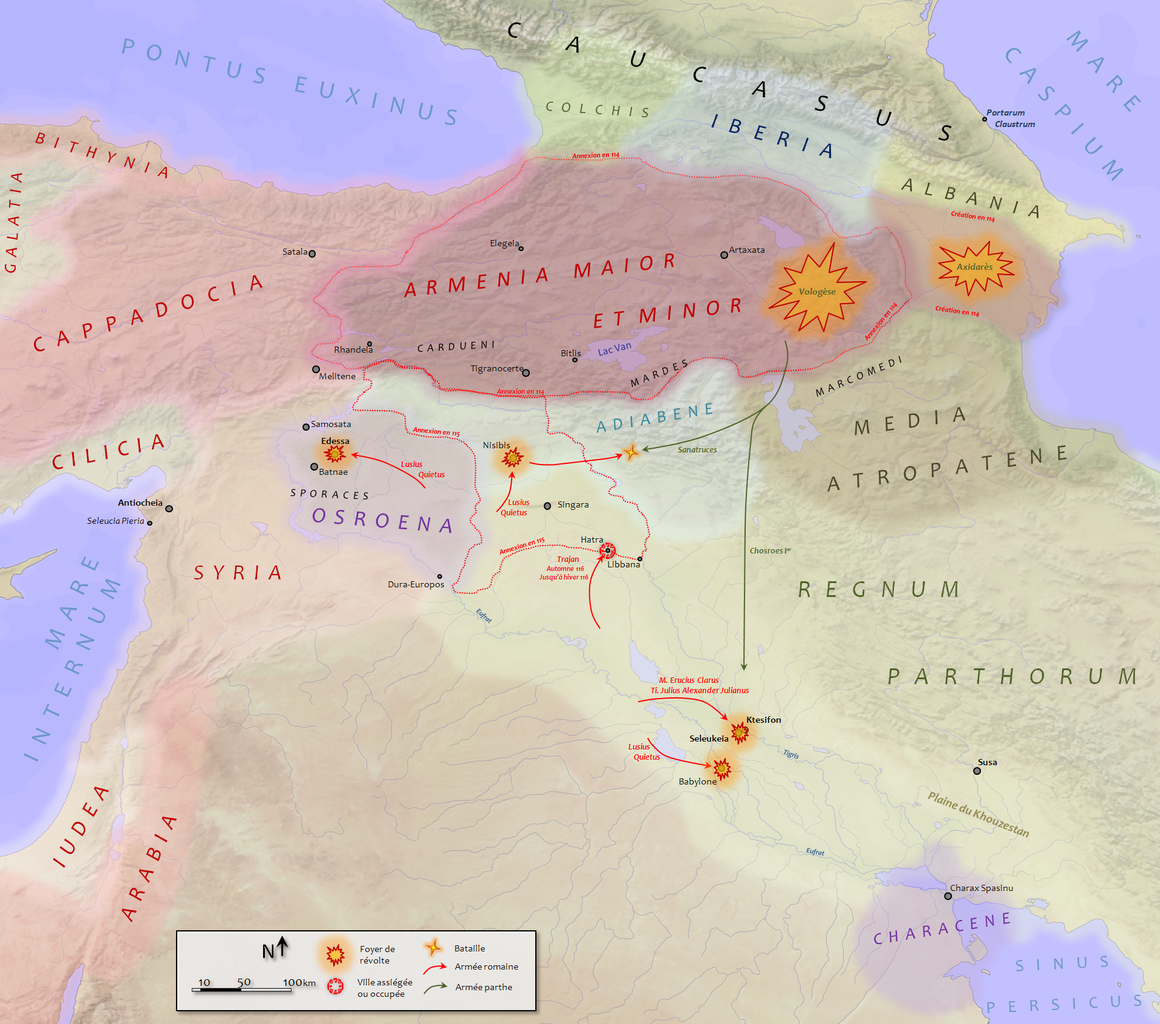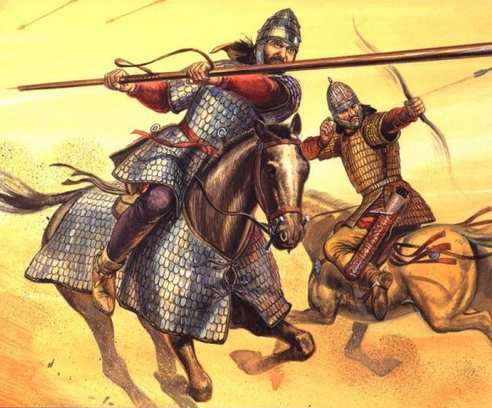
Early Han Empire (206 BC–AD 9)
Han army: up to 400,000 trained conscript soldiers.¹
300,000 soldiers mobilized and deployed in one region to
ambush a Xiongnu raiding force (133 BC).²
85,000 Han cavalry mobilized to expel the Xiongnu from
border regions (177 BC).³
Two large Han armies campaigned on the steppe each
comprising 100,000 infantry and 50,000 cavalry (119 BC). Total: 200,000
infantry and 100,000 cavalry.
Han Expansion
Han expedition across the Tarim territories to Ferghana:
60,000 soldiers, 100,000 oxen and 30,000 horses (104–101 BC).⁴
Allied Tarim kingdoms attack on the Chanyu steppe fortress:
40,000 troops (36 BC).⁵
Later Han Empire (AD 25–220)
Military units at capital Louyang: 3,536 soldiers.⁶
Northern frontier (3,100 miles): perhaps 20,000 soldiers
including the military strongholds established to monitor subject steppe
nations.⁷
30,000 Southern Xiongnu serving in the Chinese army
(campaign AD 89).⁸
Early Roman Empire (30 legions)
300,000 professional soldiers in permanent service.
Roman Legion: 5,000 legionaries and 120 cavalry.⁹
Each Legion supported by 5,000 auxiliaries.¹⁰
Each Legion supported by auxiliary Ala units comprising 500
cavalry.
Scale of Roman Military Activities (Early Imperial)
Roman army on the Rhine Frontier: 80,000 soldiers (8
legions). Comprising up to 40,000 legionaries, 40,000 auxiliaries and perhaps
5,000 cavalry.
Danube army (8 legions).
Roman army in Syria and Asia Minor: 40,000 soldiers (4
legions). Comprising up to 20,000 legionaries, 20,000 auxiliaries and perhaps
2,500 cavalry. Supported by troops raised by client kingdoms.
Roman Black Sea: 3,000 soldiers and 40 war-galleys. Over
1,000 soldiers (several cohorts) stationed in the Chersonesos client kingdom
(Crimea).¹¹

Parthian Empire (Iran-Iraq)
Mounted army: 40,000 archers and 4,000 heavily-armoured
lancers.¹²
Roman-Parthian Wars (Republican Era)
Roman invasion of Mesopotamia (Crassus, 53 BC): 35,000 Roman
infantry (7 legions) with 5,000 auxiliary cavalry.¹³
Parthian army: 9,000 mounted archers and 1,000
heavily-armoured cataphract riders.¹⁴
Casualties: 20,000 Romans killed, 10,000 captured and
transferred to Merv in Central Asia.¹⁵
Roman invasion of Media (Mark Antony, 36 BC): 60,000 Roman
infantry (from 16 legions) with 10,000 cavalry.¹⁶
Parthian army: 36,000 mounted archers and 4,000 cataphracts.
Parthian casualties at the Battle of Phraaspa (a Roman
victory): 80 dead and 30 prisoners.¹⁷
Roman casualties on campaign: 40,000 legionaries and 4,000
cavalry killed or captured.¹⁸
Western Asia
Armenian army: 10,000 armoured cavalry, 6,000 horsemen, and
30,000 infantry.¹⁹
Caucasian-Iberia: 19,000 infantry.²⁰
Roman client kingdom Commagene (Asia Minor): 2,000 cavalry,
3,000 infantry, 3,000 archers.²¹
Hellenic Armies in Central Asia (250–140 BC)
Greco-Bactrian Kingdom: 20,000 phalanx infantry and 10,000
cavalry.²²
Indo-Greek army (Hindu Kush and Indus): 60,000 mainly Indian
troops raised by levies.²³
Kushan Empire (Afghanistan and Northern India)
Defensive – Yuezhi nation: 100,000 mounted warriors.²⁴
Offensive – Kushan army: 70,000 including mounted archers
and armoured cataphract cavalry.²⁵
From military levies in India: 60,000 combatants, 200
elephants.²⁶
Xiongnu (East Asian Steppe)
Xiongnu Nation: 24 commanders leading up to 240,000 mounted
warriors.²⁷
Xiongnu Empire including steppe allies: 320,000 mounted
warriors mobilized to defend their territory (200 BC).²⁸
Offensive – 100,000 Xiongnu warriors assembled to invade
Chinese territory and seize a main city (133 BC).²⁹
Occupation – Xiongnu occupations of Han territory: 30,000 in
Shang Commandery and 30,000 in Yun-chung Commandery (158 BC).³⁰
Steppe Nations (Asian Steppe)
Wuhuan – Inner Mongolia: Subject to Han Empire and
distributed across northern Chinese frontiers. Groups of 3,000 mounted warriors
in Han service.³¹
Xianbei – Mongolian Steppe: 100,000 mounted warriors.³²
Xiongnu – East Asian Steppe: 240,000 mounted warriors.
Wusun – Ili Valley and Lake Balkhash (Central Steppe):
188,000 mounted warriors. Offensive army: 80,000 warriors.³³
Kangju – Sogdia-Ferghana: 90,000 mounted warriors.³⁴
Sakas – Ili Valley displaced to Sogdia-Bactria and moving
south to conquer the Indus Kingdoms: 20,000 mounted warriors.³⁵
Scythian army (Pontic Steppe): 30,000 mounted warriors
fighting 20,000 Siraces (Sarmatians).³⁶

Sarmatians (Western Steppe)
Alani-Aorsi (Yancai) Caspian Steppe: 100,000 mounted
warriors.³⁷
Siraces (East Pontic Steppe): 20,000 mounted warriors.³⁸
Roxolani (Pontic Steppe – Danube): 50,000 mounted
warriors.³⁹ Raiding force 9,000 warriors.⁴⁰
Iazyges (Hungary): possibly 20,000 mounted warriors. Foreign
service: 8,000 mounted warriors transferred to the Roman army after conflict
with the Empire.⁴¹
Late Antiquity:
Roman Empire – Army divided between Eastern and Western
states
389,704 soldiers with 45,562 in fleet (fourth century AD).⁴²
500,000 soldiers if at full unit strength (AD 395–420).⁴³
Steppe Invasions (fourth–fifth century AD)
‘Han Zhao’ from the Southern Xiongnu – ‘Hun-nu’ (Hexi
Corridor and Northern China): five clans providing 50,000 mounted warriors.
Sacked Chinese capitals Louyang and Chang’an and captured two Jin Emperors (AD
311–316).⁴⁴
Huns (Pontic-Caspian Steppe and Hungarian grasslands).
Offensive army: 60,000 warriors (AD 425).⁴⁵
Hunnic Empire of Attila (manpower potential)
Hungarian Plain: 20,000 mounted warriors.⁴⁶
Pontic Steppe: 70,000 mounted warriors (Goths, Scythians,
Alani, Huns).⁴⁷
Further Germanic subjects fighting as infantry. A single
Germanic faction could field 10,000 fighting men with Amal Goths, Rugians,
Scirii, Thuringians, Franks, Gepids, Burgundians and Heruli fighting in Hunnic
armies. Perhaps 80,000 Germanic fighters available for military campaigns.⁴⁸
Allied Huns/Alani from the Caspian steppe: possible 100,000
mounted warriors.⁴⁹
Germanic/Alani populations fleeing Hunnic advance
Single Germanic faction: 10,000 fighting men.
Goths: Tervingi (10,000 fighters) and Greuthungi (possibly
equivalent numbers) invade the Balkans (AD 376–378).⁵⁰
Goths led by Radagaisus invade Italy (AD 405–6) with 12,000
freemen fighters surrendering to the Roman army.⁵¹
Vandals/Alani occupy Spain and invade North Africa (409–429)
with a total population of 80,000 including women and children.⁵²
Notes: Military Capacities
1. Chu-Han Contention (206–202 BC).
2. Sima Qian, Shiji, 108.2b–3a; 110.10a–b. Hanshu, 52.8b–9a;
94a.7b–8a.
3. Chinese Historical Atlas: Chung-kuo li-shih ti-t’u chi,
2.17–18.
4. Sima Qian, Shiji, 123.3174–77; Hanshu, 96.
5. Hanshu, 70.3b.
6. Scheidel, ‘State Revenue and Expenditure in the Han and
Roman Empires’ (2012), 23.
7. Dunhuang-Shuofang frontier (620 miles): 3,250 soldiers
(Loewe, The Men who Governed Han China (2004), 63).
8. Chu-Han Contention (206–202 BC).
9. Josephus, Jewish War, 3.6.2 (cavalry).
10. Tacitus, Annals, 4.5.
11. Josephus, Jewish War, 2.16.3; Tacitus, Annals, 12.15.
12. Plutarch, Antony, 44 (40,000 Parthians); Crassus, 21.
(ratio cataphracts to archers).
13. Plutarch, Crassus, 20.
14. Ibid., 21.
15. Ibid., 31.
16. Plutarch, Antony, 37–8.
17. Ibid., 39.
18. Ibid., 50–51.
19. Plutarch, Crassus, 19.
20. Plutarch, Pompey, 34.
21. Josephus, Jewish War, 2.18.9 (AD 66).
22. Diodorus, 18.7; Polybius, 10.49.
23. Justin, 41.6.4.
24. Hou Hanshu, 88.13.
25. Ibid., 77.4a–7a.
26. Arrian, Alexander, 6.2.2.
27. Sima Qian, Shiji, 110:9b–10b (Title: ‘Chief of Ten
Thousand Horsemen’ with some commanding smaller forces).
28. Sima Qian, Shiji, 110.6b; Hanshu, 94a.4b.
29. Sima Qian, Shiji, 108.2b–3a; 110.10a–b; Hanshu,
52.8b–9a; 94a.7b–8a.
30. Chung-kuo li-shih ti-t’u chi, 2:17–18.
31. Hou Hanshu, 103:1a.
32. Ch’uan Hou-Han Wen, 73.1b; Hou Hanshu, 120.5b.
33. Hanshu, 61; 96.
34. Sima Qian, Shiji, 123.3b.
35. Ctesias, Fragment, 1.7 (Sakas fighting for Persian King
Cyrus in 530 BC).
36. Lucian, Toxaris, 39.
37. Sima Qian, Shiji, 123.
38. Strabo, 11.5.8.
39. Strabo, 7.3.17.
40. Tacitus, Histories, 1.79.
41. Dio, 72.15–16.
42. John Lydus, De Mensibus, 1.27.
43. Notitia Dignitatum (The List of Offices).
44. Zizhi Tongjian, 96. Grousset, The Empire of the Steppes
(1970), 56.
45. Philostorgius, 12.14.
46. Dio, 72.15–16 (Iazyges); Linder, ‘Nomadism, Horses and
Huns’ in Past and Present, 92.1 (1981) 3–19 (estimates 15,000 mounted warriors
based on grassland capacity and ten mounts per rider).
47. Figures suggested by Siraces and Roxolani fielding
20,000 and 50,000 mounted warriors.
48. Battle of the Catalaunian Plains (AD 451).
49. Sima Qian, Shiji, 123 (military potential); Ammianus,
31.3.1(Alani merged with Huns); Priscus, Fragment, 11.2 (Attila planned to
invade Persia through Caucasus).
50. Ammianus, 31.12.
51. Olympiodorus, Fragment, 9
52. Victor Vitensis, History of the Persecution, 1.2.